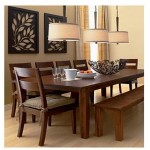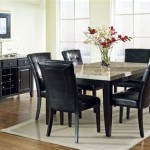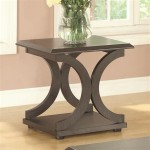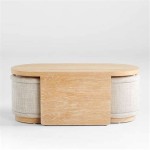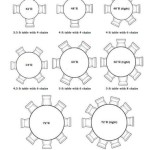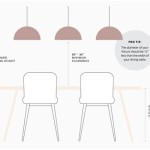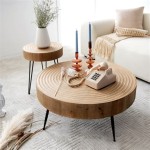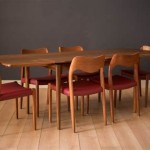Choosing the Right Round Table to Seat 8: A Comprehensive Guide
Selecting a round table to comfortably accommodate eight individuals requires careful consideration of several factors. Overlooking these aspects can lead to an uncomfortable dining or meeting experience. Key considerations include table diameter, available space, material choice, and overall design aesthetic. This article will explore these elements in detail, providing insights to aid in the decision-making process.
Understanding Diameter Requirements for Seating Capacity
The primary factor influencing the selection of a round table is its diameter. An insufficient diameter will result in cramped seating arrangements, making it difficult for individuals to move freely and engage comfortably in conversation. Conversely, an excessively large table may dominate the room and hinder movement around the space. A general rule of thumb suggests allocating a minimum of 24 inches (61 cm) of width per person at the table. This space allows for adequate elbow room and personal space.
Applying this principle to a table seating eight individuals, the minimum circumference required would be 8 persons * 24 inches/person = 192 inches. This circumference translates to a diameter of approximately 61 inches (155 cm). However, a 61-inch table would likely feel quite tight. For a more comfortable experience, a diameter of 60-72 inches (152-183 cm) is generally recommended. This range provides ample space for each person and allows for the placement of dishes and serving platters without crowding the table.
It is important to note that these are minimum recommendations. Factors such as the style of chairs used can also influence the ideal table diameter. Chairs with arms, for instance, will necessitate a slightly larger diameter to prevent crowding. Similarly, if the table is intended for formal dining with multiple courses, a larger surface area will be beneficial to accommodate various dishes, glassware, and silverware.
Beyond the pure numerical calculations, it is beneficial to physically mock up the seating arrangement. Using chairs and a makeshift circular area (e.g., marking a circle on the floor with tape), one can visually assess the comfort level and spacing before committing to a purchase. This proactive approach can prevent costly and inconvenient errors.
The shape of the table base also plays a role in the overall dining experience. A pedestal base, while aesthetically pleasing, might restrict legroom for individuals seated directly beside it. Alternatively, tables with four legs positioned at the corners offer more freedom of movement for those seated around the table. Consideration should be given to the placement and design of the base to maximize comfort and accessibility for all diners.
Considerations for Available Space and Room Layout
Before purchasing a round table, it is crucial to assess the available space in the intended room. A large table in a small room can create a cramped and claustrophobic atmosphere, hindering movement and diminishing the overall aesthetic appeal. Conversely, a small table in a large room can appear disproportionate and insignificant.
To determine the appropriate table size, measure the dimensions of the room and consider the existing furniture and traffic flow. A general guideline suggests leaving at least 36 inches (91 cm) of space between the edge of the table and any walls or other furniture items. This space allows for comfortable passage around the table without bumping into objects or obstructing walkways.
Furthermore, consider the shape of the room. Round tables often work well in square or circular rooms, as they complement the existing geometry. In rectangular rooms, a round table can create a focal point and soften the angular lines. However, it is essential to ensure that the table does not impede movement or create awkward corners. Visualizing the table in the space, either through sketching or using online room planning tools, can be helpful in determining the optimal placement and size.
The location of doorways and windows should also be taken into account. Placing a large round table directly in front of a doorway can obstruct access and create a bottleneck. Similarly, positioning the table near a window may expose diners to glare or drafts. Careful consideration of these factors will contribute to a more comfortable and functional dining environment.
An additional consideration is the presence of other furniture in the room. Buffets, sideboards, and display cabinets can all impact the available space and influence the optimal table size. If the room already contains several large furniture pieces, it may be necessary to opt for a smaller table to avoid overcrowding. Alternatively, if the room is relatively empty, a larger table can help to fill the space and create a more inviting atmosphere.
Material Choices and Design Aesthetics
The material of the round table significantly impacts its durability, maintenance requirements, and overall aesthetic appeal. Common materials include wood, metal, glass, and stone, each offering distinct advantages and disadvantages. The choice of material should be guided by the intended use of the table, the desired style, and the level of maintenance that one is willing to undertake.
Wood tables offer a classic and timeless aesthetic. They are available in a wide variety of finishes and styles, ranging from rustic to contemporary. Different wood species exhibit varying levels of durability and resistance to scratches and dents. Hardwoods such as oak, maple, and cherry are known for their strength and longevity, while softwoods such as pine and cedar are more susceptible to damage. Wooden tables require regular cleaning and polishing to maintain their appearance and prevent moisture damage. Consider the existing wood tones in the room to ensure a cohesive look.
Metal tables offer a sleek and modern aesthetic. They are often made from steel, aluminum, or wrought iron. Metal tables are generally durable and resistant to scratches and stains. They are also relatively easy to clean and maintain. However, metal tables can be cold to the touch and may require the use of placemats or coasters to protect the surface. Metal tables are well-suited for contemporary or industrial-style dining rooms.
Glass tables offer a sophisticated and elegant aesthetic. They can create a sense of openness and lightness in a room. Glass tables are relatively easy to clean, but they are also susceptible to scratches and fingerprints. Tempered glass is recommended for dining tables, as it is more resistant to breakage than regular glass. Glass tables are well-suited for formal dining rooms or spaces where a minimalist aesthetic is desired.
Stone tables, such as those made from marble or granite, offer a luxurious and durable option. They are highly resistant to scratches, stains, and heat. Stone tables are also relatively easy to clean, but they can be heavy and difficult to move. Stone tables are well-suited for formal dining rooms or spaces where a high-end aesthetic is desired.
Beyond the core material, the design of the table base also contributes significantly to the overall aesthetic. Pedestal bases offer a clean and uncluttered look, while four-legged bases provide a more traditional and stable feel. The legs can be made from a variety of materials, such as wood, metal, or acrylic, and can be adorned with decorative details to enhance the style of the table. The chosen base should complement the tabletop material and the overall design of the room.
Ultimately, the most suitable round table for seating eight will depend on a combination of factors: the desired comfort level, the available space, and the preferred aesthetic. A thorough evaluation of these elements will ensure that the selected table meets the specific needs and enhances the overall dining or meeting experience.

Luxury Custom 8 Seat Round Dining Table 28180 Room Home Furniture Interior Design

Round Dining Tables Connecticut In Style Table Sizes Dimensions Room

Round Dining Table Seats 8 Transitional Room Beamin Moore Morning Dew Paul Moon Design

Round Table Seating Guide Diy Kitchen Dining Room

Everything About Your Round Dining Table For 8 People

7 Wonderful Round Dining Room Tables Seats 8 Collection Seater Table 8se Sets

Round Dining Tables For 8 Ideas On Foter Room Table Sets

The Beauty Of Round Dining Tables And Some Fun Entertainment Classic Casual Home

J E Home 59 06 In Modern Round White Marble Tabletop Dining Table With Carbon Steel Base Seats 8 Pvs Dt012jx03 The

Cuba 8 Seat Set With 170cm Round Table Light Grey Rathwood

